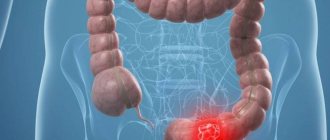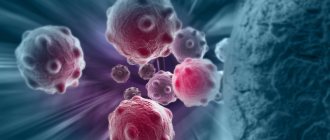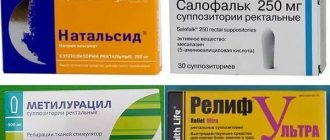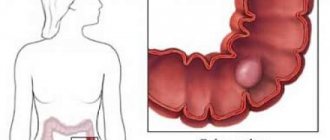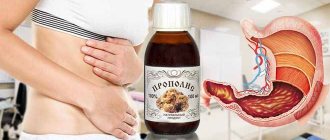Sigmoiditis is an inflammatory process that is characterized by damage to the inner layer of the sigmoid colon. According to official statistics, the disease is more often diagnosed in women aged 20 to 55 years. In men - mainly after 45 years. Manifests itself in the form of chronic inflammation associated with intestinal dysbiosis, ascending infection from the rectum, and decreased immunity. Today, sigmoiditis is one of the curable diseases. It can be stopped with the help of modern drugs that eliminate the symptoms of inflammation and stimulate the restoration of damaged mucous membranes.
CAUSES OF SIGMOIDITIS
The disease can occur for various reasons. The most common culprits of the inflammatory process in the sigmoid colon are:
- microtraumas in the wall of the large intestine, provoked by disruption of the normal act of defecation, in particular, constipation;
- the appearance of pathogenic flora during dysbacteriosis, which contributes to the development of inflammation;
- severe disruption of blood microcirculation in the affected area with the appearance of ischemic areas;
- spread of infection to adjacent tissues with anal fissures, hemorrhoids, paraproctitis;
- exacerbation of chronic inflammatory processes of the genitourinary area in men and women;
- development of complications after intestinal surgery;
- decreased immunity leading to activation of pathogens;
- destruction of the mucous membrane of the large intestine under the influence of aggressive chemotherapy drugs in the treatment of oncology;
- enlargement of the fetus during pregnancy, which provokes congestion in the compressed intestines and, as a result, inflammation.
Symptoms
Are common
With inflammation of the sigmoid colon, patients with any form of the disease complain of:
- diarrhea;
- stool at night;
- tenesmus;
- abdominal pain (strong and moderate in the left half of the abdomen with radiation to the left leg and lumbar region);
- weight loss;
- bloating;
- rumbling;
- flatulence;
- foul-smelling stool mixed with mucus.
Due to the intense inflammatory process, the barrier function of the large intestine is disrupted. Harmful substances enter the blood and cause endotoxemia syndrome, manifested by:
- fever;
- general weakness;
- depression;
- tachycardia;
- anorexia;
- nausea.
The nature of the main manifestations, their intensity and severity, depends on the type of sigmoiditis.
Ulcerative sigmoiditis
Regardless of the cause of inflammation, if ulcers have formed on the mucous membrane of the sigmoid colon, patients complain of:
- Presence of blood in the stool. With sigmoiditis, scarlet blood is released during bowel movements. These may be streaks of blood, minor discharge, or intense intestinal bleeding. When the proximal intestine becomes inflamed, the blood mixes with the stool and is darker.
- Motor impairment. Sigmoiditis is characterized by diarrhea. The frequency of stools is up to 20 times a day. Ulcerative sigmoiditis is characterized by frequent bowel movements at night. If the disease is mild, then stool occurs no more than 5 times a day. Blood and mucus are found in the stool. Constipation occurs less frequently. They are more typical for proctosigmoiditis (when the rectum is involved in the pathological process).
- Tenesmus. False urge to defecate occurs with severe inflammation in the sigmoid colon. At the same time, stool frequency is within normal limits. Patients complain of a feeling of incomplete emptying of the rectum.
- Abdominal pain. When the sigmoid colon is affected, it appears in the lower abdomen, intensifies before the act of defecation, and disappears after it. Most often, patients complain of a feeling of discomfort. If all layers of the intestinal wall are involved in the pathological process, the pain becomes severe.
- Sudden weight loss. Due to frequent pain, appetite decreases. The inflammatory process in the intestines leads to impaired absorption of nutrients. Accordingly, body weight decreases sharply.
- Extraintestinal manifestations. Inflammation is accompanied by an increase in body temperature. When the intestines are damaged (especially if sigmoiditis is caused by infection), symptoms of intoxication appear. Anemia occurs in severe cases, due to frequent bleeding and impaired absorption processes.
Be sure to read: The main symptoms of appendicitis
All these symptoms occur most intensely during the fulminant course of sigmoiditis. In this case, the disease begins suddenly. Bloody diarrhea more than 30 times a day. Body temperature rises sharply, and symptoms of intoxication quickly increase. Complications arise instantly, which without urgent surgical intervention lead to death within 24 hours.
Catarrhal sigmoiditis
Non-ulcerative sigmoiditis occurs in a milder form. It is characterized by:
- Abdominal pain. It occurs in the lower abdomen, around the navel, and radiates to the back. It intensifies 5–7 hours after eating, with body shaking or jumping. Products that increase gas formation contribute to its intensity. It decreases after defecation and the passage of gases.
- Diarrhea. Most often occurs in the morning, after eating. Feces are scanty, unformed with mucus. Diarrhea alternates with constipation, feces become fragmented (like “sheep”, ribbon-like, cord-like). Feces are liquefied by mucus and inflammatory exudate. Diarrhea increases after eating fatty foods, milk, dietary fiber, and legumes.
The catarrhal form is accompanied by nausea, dryness and bitterness in the mouth, and belching of air.
Nonspecific ulcerative sigmoiditis
Since this type of disease is caused by a malfunction in the immune system, in addition to the typical symptoms of ulcerative sigmoiditis, it is characterized by autoimmune systemic manifestations:
- joint damage (arthralgia, arthritis, spondyloarthritis);
- dermatitis;
- erythema nodosum;
- aphthous stomatitis;
- pyoderma gangrenosum;
- trophic ulcers of the lower extremities;
- osteoporosis;
- liver damage;
- eye damage (conjunctivitis, cataracts, optic neuritis, etc.).
An accurate diagnosis is established after a thorough examination, which includes a morphological and histological examination of a biopsy taken from the affected mucous membrane (see intestinal biopsy).
Ischemic sigmoiditis
Ischemic sigmoiditis occurs when the blood supply to the sigmoid colon is disrupted. There are 3 types of it, and each type of disease is characterized by certain symptoms:
- Transitional. It manifests itself as cramping pain in the abdomen, occurring 20–60 minutes after eating, due to physical activity, change in body position. The pain is accompanied by bloating. Attacks of pain at the height of digestion occur due to reflex spasm of blood vessels and are called “abdominal pain.” Intestinal motility is impaired and constipation occurs. Due to insufficiency of the anal sphincters, patients complain of unstable stools.
- Stricturing. Occurs with prolonged circulatory disorders. Patients complain of cramping abdominal pain, constipation, poor gas discharge, and rumbling in the abdomen. Rectal examination reveals bloody mucus.
- Gangrenous. The most severe form of ischemic sigmoiditis. Due to impaired blood circulation, necrosis, gangrene of the colon, and diffuse peritonitis occur. It manifests itself as unbearable pain, bloody diarrhea, and low blood pressure. When examined, patients are restless. The skin is pale, with an ashen tint, the tongue is dry, the stomach does not participate in the act of breathing. Urgent surgery is necessary, as the likelihood of death is high.
Radiation sigmoiditis
It is mainly observed in patients who have undergone radiation therapy for cancer of the sigmoid and rectum. It is characterized by typical symptoms of inflammation:
- tenesmus;
- spastic pain in the left iliac and anorectal regions;
- diarrhea;
- intestinal bleeding.
Among all types of radiation damage to the intestine, sigmoiditis and proctosigmoiditis are the most severe. The prognosis of the disease is unfavorable.
Microscopic and lymphocytic sigmoiditis
The development of these types of sigmoiditis is associated with autoimmune reactions. Manifests:
- watery diarrhea (stool frequency 3–5 times per bowel movement);
- moderate loss of body weight;
- spastic, not intense pain.
Be sure to read:
Intestinal colonoptosis: definition, symptoms, treatment and prognosis
The disease is difficult to treat and can last for years.
Pseudomembranous sigmoiditis
Symptoms of the disease appear a few days after the start of antibiotic therapy. Sometimes the disease develops a month after the first dose of antibiotics. Leading symptoms:
- profuse watery diarrhea;
- fecal matter mixed with blood;
- cramping abdominal pain;
- high body temperature (more than 38.4 °C);
- signs of dehydration (dry skin, etc.);
- heart rhythm disturbance.
Symptoms often disappear after stopping antibiotic therapy.
TYPES OF INFLAMMATION OF THE SIGMOID COLOUS
Depending on the nature of the inflammatory process, it is customary to distinguish the following types of sigmoiditis:
- catarrhal type: inflammation extends only to the superficial layers of the mucous membrane of the sigmoid colon;
- erosive sigmoiditis: characterized by damage to the deep layers of the intestine and is accompanied by the development of bleeding;
- ulcerative or purulent-hemorrhagic sigmoiditis with multiple ulcerations of the mucous membranes;
- perisigmoiditis and inflammation of the mesentery: leads to the formation of adhesions between intestinal loops.
Risk factors and main causes
The causes of inflammation of the sigmoid colon must be known in order to prevent recurrence of the pathology, since drug therapy alone will not give a stable positive result: for a complete recovery, the patient will have to follow a gentle diet and adjust their lifestyle. Insufficient intake of plant fiber leads to the gradual development of chronic colitis and sigmoiditis. Coarse fibers are not digested in the intestines and are excreted from the body almost unchanged, absorbing toxins and allergens that settle on the mucous membranes of the intestinal walls. If the body does not receive the required amount of fiber, toxic substances and waste products of microorganisms inhabiting the intestinal microflora remain in the intestines and can cause inflammation.
Sigmoiditis
Other possible causes of sigmoiditis include:
- conditions that provoke intestinal dysbiosis (taking antibiotics and antimicrobial agents, low content of fermented milk products in the diet);
- factors that negatively affect the state of the immune system (smoking, alcohol abuse, sedentary lifestyle, short and irregular walks);
- dietary errors (increased consumption of spicy and fatty foods);
- infections of the anorectal area.
Poor nutrition is one of the possible reasons
Note! Sigmoiditis can be a consequence of chronic intestinal diseases and partial dysfunction of the digestive system, therefore people registered with a gastroenterologist or coloproctologist are at increased risk for this pathology.
Causes of sigmoiditis
FEATURES OF SIGMOIDITIS
The main symptoms of the disease depend on the type of pathology, the severity of the inflammatory process and the presence of complications. Among the most characteristic manifestations of the disease are:
- lower abdominal pain;
- violation of the act of defecation (diarrhea);
- general weakness and malaise.
With sigmoiditis, pain radiates to the left leg or lumbar region. In such patients, blood inclusions are often detected in the stool, and the stool itself is foul-smelling and has a foamy consistency.
DIAGNOSIS OF SIGMOIDITIS
If symptoms characteristic of sigmoiditis appear, it is recommended to immediately consult a doctor. Modern medicine has a sufficient number of diagnostic techniques that make it possible to accurately determine one or another type of sigmoiditis in a patient:
- colonoscopy - examination using a special endoscope of individual areas of the large intestine;
- sigmoidoscopy – instrumental examination of the rectum and lower parts of the sigmoid colon;
- irrigoscopy - x-ray examination of the intestine with the introduction of a contrast agent;
- computed tomography and MRI are the most informative modern methods for diagnosing tumors, ulcers and inflammatory processes in the distal parts of the large intestine.
Additionally, patients with suspected sigmoiditis may be prescribed blood and urine tests, serological tests, and ultrasound examination.
TREATMENT OF SIGMOIDITIS
Treatment of inflammation in the sigmoid colon is a rather lengthy and expensive process. The results of therapy largely depend on how diligently the patient follows the recommendations of the attending physician.
The main thing is to stop the inflammation and restore the mucous membrane of the gastrointestinal tract, so the emphasis should be on antibacterial drugs and gastroenteroprotectors (rebamipide, rebagit). Analgesics and antispasmodics will help cope with pain, probiotics will help restore the microflora.
The basis of treatment for sigmoiditis is:
- drugs to protect and restore the intestinal mucosa (gastroenteroprotectors);
- adsorbents for removing waste;
- antibacterial drugs to eliminate the source of infection in the sigmoid colon;
- drugs to reduce stomach acidity;
- probiotics to normalize normal intestinal microflora;
- analgesics to relieve pain;
- antispasmodics to reduce spastic phenomena in the large intestine;
- in severe forms of the disease, patients are prescribed intravenous injections of detoxification solutions and a mixture of amino acids.
Diet plays an important role in the treatment of sigmoiditis. Limiting the consumption of fatty foods and carbohydrates eliminates the processes of fermentation and putrefaction that cause irritation of the intestinal walls. Patients suffering from sigmoiditis are advised to eat frequent and small portions of liquid, viscous meals without lumps or other solid particles. For sigmoiditis accompanied by severe diarrhea, diet No. 4 is indicated. Due to insufficient calories, this diet is usually prescribed for no more than 7 days. In severe cases, patients with sigmoiditis are advised to fast and drink plenty of fluids for 1-2 days.
Treatment
Treatment of sigmoiditis is complex. It is aimed at:
- eliminating the cause of the disease;
- reduction of the inflammatory process;
- healing of ulcers;
- preventing relapses.
To get rid of the disease, you must stop smoking, adhere to a special diet, and completely complete the course of treatment prescribed by your doctor. Well, as a complement to the main therapy (after preliminary consultation with a specialist), use traditional methods.
Diet
Enteral nutrition is a mandatory component of the treatment of sigmoiditis. In case of exacerbation of the disease, treatment table No. 4 is recommended.
It is not advisable for patients to use:
- milk;
- fresh vegetables and fruits (they can only be boiled or thoroughly ground);
- spices;
- fresh flour products;
- canned food;
- honey, jam.
When selecting dishes, it is taken into account that patients need easily digestible protein, and fats must be limited. Recommend:
- white bread crackers;
- weak meat broths;
- slimy soups (buckwheat, rice);
- grated meat (lean), steamed;
- egg white omelet;
- lean fresh fish;
- butter;
- cottage cheese;
- weak tea;
- jelly;
- decoction of black currants, blueberries.
Diet is not only about selecting permitted foods. If you have sigmoiditis, you need to eat every 2–3 hours (it is not recommended to eat before going to bed or at night), in small portions.
If the patient suddenly loses weight, or sigmoiditis occurs in a fulminant form, patients are shown parenteral nutrition. Intravenous administration of glucose solutions, electrolytes, protein preparations, intralipid, lipofundin is prescribed.
Be sure to read:
Rectal cancer: symptoms, stages, treatment and prognosis for life
Drugs
For the treatment of sigmoiditis the following is prescribed:
- Basic anti-inflammatory. For mild cases of the disease, 5-aminosalicylic acid preparations (salofalk, mesalazine, pentas) are prescribed. In severe cases, corticosteroids. For sigmoiditis, it is more advisable to use them topically in the form of rectal suppositories and enemas.
- Antispasmodics. Relieve muscle spasm, eliminate pain.
- Antidiarrheal drugs. Prescribed: Loperamide, Smecta, Enterosgel.
- Antiulcer. They are prescribed for the rapid healing of ulcers and erosions.
- Probiotics. They are necessary to restore intestinal microflora.
For autoimmune reactions, immunosuppressants are prescribed.
For the treatment of ischemic sigmoiditis, drugs are prescribed that restore and improve blood circulation. Surgery is often required. Therefore, consultation with a vascular surgeon or angiologist is necessary.
If the disease is severe or complications arise, surgical treatment is mandatory.
Folk remedies
Traditional methods of treatment are used as an additional component of complex treatment. They are recommended to relieve symptoms of the disease. Since defecation is painful with sigmoiditis and proctosigmoiditis, it is recommended to induce stool with an enema with chamomile infusion.
For diarrhea with bloody discharge, drink decoctions from:
- rhizomes of Potentilla erecta;
- rhizomes of burnet;
- shepherd's purse herbs.
To reduce fermentation and putrefactive processes, decoctions are prescribed:
- oak bark;
- alder cones;
- bird cherry fruit.
Traditional methods do not treat sigmoiditis, but only reduce the manifestations of the main clinical manifestations. If you refuse to diet, and even more so take medications, complications of sigmoiditis will arise.
Read more: Herbs for the intestines: names of medicinal plants and their use
CONSEQUENCES OF THE DISEASE
Lack of timely treatment is dangerous for the rapid development of complications, which often pose a threat to the patient’s life. The most common complications of the pathological process in the sigmoid colon include:
- toxic dilatation (expansion) of the large intestine;
- malignancy (malignancy) of the inflammation zone;
- perforation of the wall of the sigmoid colon with the development of internal bleeding;
- obstruction of the colon;
- purulent peritonitis of the abdominal cavity;
- septic blood poisoning;
- thrombosis of the mesenteric artery.
All these conditions are dangerous with a high risk of death. Therefore, if symptoms of sigmoiditis appear, you should immediately seek medical help.
